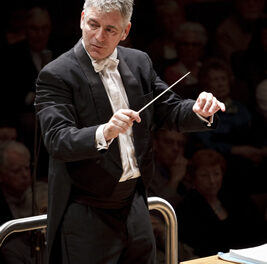For Charlotte Symphony guest conductor Paolo Bortolameolli, Satie, Stravinsky, and Beethoven all have at least one thing in common: music of modernity. Connecting the dots of this unusual programming, Bortolameolli explained how the programmed works from these composers reflect their fixations with the future of art music. Often to the detriment of his public reception, Satie wrote music with the goal of rejecting attitudes of pretentiousness surrounding art in Europe. Stravinsky was writing music in collaboration with Sergei Diaghilev of the Ballets Russes which was so artistically radical that it left Parisians rioting in the streets. Even Beethoven, who Bortolameolli boldy claims is the most modern composer of all, was restructuring the legacy of symphonic form by his second symphony.
But modernity isn’t the only thread bringing these three composers together. Pablo Picasso also has a place alongside these three. The Charlotte Symphony presents this concert in collaboration with the Mint Museum’s Out of Bounds exhibit which features a collection of Picasso landscapes. Known chiefly for his cubist portraits, Picasso was also an influential costume and set designed for the Parisian ballet company, the Ballets Russes. As impressiario of the Ballets Russes, Sergei Diaghilev wanted to completely reimagine art in Paris and Europe at large by bringing together the greatest artistic minds of the early 1900s. And bringing together the greatest artistic minds meant combining music, dance, and visual art. Alongside Diaghilev, Picasso designed the costumes and sets for Satie’s Parade and Stravinsky’s Pulcinella. When it was premiered, Satie’s music for Parade challenged what audiences even understood as serious art music. The ballet’s plot presents a circus group trying to lure in an audience to their show by putting on an outside preview performance. The performers attract a lively crowd but to the circus’ dismay, the audience has mistaken the preview for the actual performance and leaves the show completely unattended. Mirroring the plot in the score, Satie removes most senses of structural harmonic progressions, disorienting and disarming the listener and rendering the piece completely nonteleological. Reveling in the simplicity of the piece’s aimlessness, CSO warmed up a tone of lightness and playfulness. And unlike the music of France’s impressionist movement where scenes blend together into a hazy spin of color, Parade is like Picasso’s style of cubism: colorful but angular and full of defined edges. Taking the piece over the top with comedic silliness, percussionist Brice Burton got quite a few laughs out of the audience for his punctuated balloon popping, siren wailing, and his virtuosic solo playing the extremely sensitive hand-tap shoes. True to form, the piece ends without any cadential indication, making the audience question, “Was that really the end?”
Even more than Satie, Stravinsky’s relationship with the Ballets Russes is a notoriously famous one in classical music. Their collaboration produced some of the most riotous and revolutionary music of the period like Petrouchka (1911), The Firebird (1910), and most notably, The Rite of Spring (1913). As groundbreaking as Stravinsky’s writing was, he often derived his source materials from the past. And in Pulcinella (1922), Stravinsky reimagines the music of the Baroque Era with a contemporary lens. In almost total contrast to the silly simplicity of Parade, Pulcinella is elegant and ornate. Written for a reduced orchestra, I could clearly hear moments of Vivaldi from the violin solos, Bach from the cello, and Corelli from the trumpet. And occasionally between monologues of Baroque concerto grosso, Stravinsky adds an interlude of his signature style or features a more contemporary instrumentation of piccolo and string bass. But the quirky first half was not lost on the audience, as both pieces were received with great enthusiasm.
I’ve earned a reputation among friends and colleagues for being a little bit of a “Beethoven bully.” Especially on a program intended to showcase modernity without including any genuinely contemporary works, I was less than optimistic thinking how Beethoven was going to land with me. But the framing presented by Bortolameolli’s programming gave an exciting reexploration of Beethoven and turned into one of the most enjoyable orchestral performances of Beethoven I’ve been to in some years. Beethoven’s 2nd is somewhat overshadowed by his 1st and certainly the 3rd symphony “Eroica,” but I found it particularly charming, uncharacteristically optimistic, and almost Mendelssohnian. And while the symphony does occasionally retreat into moments of dismay, the way CSO leaned into these contrasts gave them an attitude of almost self-aware melodrama. A hugely successful performance, the audience felt impassioned enough to give three boisterous rounds of applause.
Charlotte Symphony is truly lucky to enjoy a partnership with the Mint Museum and in the future I hope to see that relationship bring an even more evocative experience to audiences. I’m sure that relocating Picasso originals is no small task, but these organizations have a real opportunity to create a rich audio-visual experience by giving artworks a place on the same stage as the performers.
This performance repeats Saturday, March 11. See our sidebar for details.











